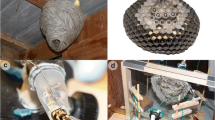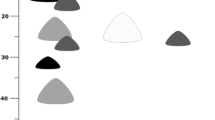Summary
-
1.
Exterior workers of the harvester ant, Pogonomyrmex owyheei, were subdivided into forager, defender and refuse worker behavior roles (Fig. 2). Exterior workers comprised approximately 16% of the total colony population with interior workers comprising the remainder.
-
2.
An average of less than 10% of the total worker population foraged (Table 1). Studies of role changes comfirmed a general one-way progression from interior workers to defenders to foragers (Fig. 5). The average longevity of foragers was about 14 days. As interior workers progressed toward foraging, their dry weights declined approximately 40% (Fig. 3) and mandible wear increased (Table 2).
-
3.
Based on these results, we propose that P. owyheei has evolved a disposable forager strategy that tolerates high forager mortality. The large reservoir of interior workers required by this strategy may also inhibit the evolution of physically specialized interior worker castes.
Similar content being viewed by others
References
Ayre GL (1962) Problems in using the Lincoln Index for estimating the size of ant colonies (Hymenoptera: Formicidae). J NY Entomol Soc 70:159–166
Bailey NTJ (1951) On estimating the size of mobile populations from recapture data. Biometrika 38:293–306
Brian MV, Abbott A (1977) The control of food flow in a society of the ant Myrmica rubra L. Anim Behav 25:1047–1055
Chapman DG, Junge CO (1956) The estimation of the size of a stratified animal population. Ann Math Stat 27:375–389
Clark WH, Comanor PL (1975) Removal of annual plants from the desert ecosystem by western harvester ants. Environ Entomol 4:52–56
Darroch JN (1961) The two-sample capture-recapture census when tagging and sampling are stratified. Biometrika 48:241–260
Dethier VG (1976) The hungry fly: A physiological study of the behavior associated with feeding. Harvard University Press, Cambridge
De Vita J (1979) Mechanisms of interference and foraging among colonies of the harvester ant Pogonomyrmex californicus in the Mojave Desert. Ecology 60:729–737
Erickson JM (1972) Mark-recapture techniques for population estimates of Pogonomyrmex ant colonies: An evaluation of the 32P technique. Ann Entomol Soc Am 65:57–61
Evans HE (1962) A review of nesting behavior of digger wasps of the genus Aphilanthops, with special attention to the mechanics of prey carriage. Behaviour 19:239–260
Feeny PP (1976) Plant apparency and chemical defense. Rec Adv Phytochem 10:1–40
Gentry JB (1974) Response to predation by colonies of the Florida harvester ant, Pogonomyrmex badius. Ecology 55:1328–1338
Gentry JB, Stiritz KL (1972) The role of the Florida harvester ant, Pogonomyrmex badius, in old field mineral nutrient relationships. Environ Entomol 1:39–41
Golley FB, Gentry JB (1964) Bioenergetics of the southern harvester ant, Pogonomyrmex badius. Ecology 45:217–225
Higashi S (1974) Worker polyethism related with body size in a polydomous red wood ant, Formica (Formica) yessensis Forel. J Fac Sci Hokkaido Univ Ser 6 19:695–705
Hölldobler B (1970) Steatoda fulva (Theridiidae), a spider that feeds on harvester ants. Psyche 77:202–208
Hölldobler B (1976) Recruitment behavior, home range orientation and territoriality in harvester ants, Pogonomyrmex. Behav Ecol Sociobiol 1:3–44
Jorgensen CD (1979) Raft River environmental report. Report to EG&G Idaho, Inc. and Department of Energy (no pagination)
Jorgensen CD, Porter SD (in press) Foraging behavior of Pogonomyrmex owyheei in southeast Idaho. Environ Entomol
Knowlton GF (1974a) Arthropod food of Curlew Valley lizards. Utah St Univ Ecol Ctr, Terrestrial Arthropod Ser 7
Knowlton GF (1974b) Some terrestrial arthropod food of Curlew Valley birds. Utah St Univ Ecol Ctr, Terrestrial Arthropod Ser 8
Kruk-de Bruin M, Röst LCM, Draisma FGAM (1977) Estimates of the number of foraging ants with the Lincoln-index method in relation to the colony size of Formica polyctena. J Anim Ecol 46:457–470
Lavigne RJ (1969) Bionomics and nest structure of Pogonomyrmex occidentalis (Hymenoptera: Formicidae). Ann Entomol Soc Am 62:1166–1175
Lewis T, Pollard GV, Dibley GC (1974) Rhythmic foraging in the leaf-cutting ant Atta cephalotes (L.) (Formicidae: Attini). J Anim Ecol 43:129–141
Mirenda JT, Vinson SB (1981) Division of labour and specification of castes in the red imported fire ant Solenopsis invicta Buren. Anim Behav 29:410–420
Oster GF, Wilson EO (1978) Caste and ecology in the social insects. Princeton University Press, Princeton
Pianka ER, Parker WS (1975) Ecology of horned lizards: A review with special reference to Phrynosoma platyrhinos. Copeia 1975:141–162
Porter SD, Eastmond DA (in press) Euryopis coki (Theridiidae), a spider that preys on Pogonomyrmex ants. J Arachnol
Porter SD, Jorgensen CD (1980) Recapture studies of the harvester ant, Pogonomyrmex owyheei Cole, using a fluorescent marking technique. Ecol Entomol 5:263–269
Rogers LE (1974) Foraging activity of the western harvester ant in the shortgrass plains ecosystem. Environ Entomol 3:420–424
Rogers LE, Lavigne RJ, Miller JL (1972) Bioenergetics of the western harverster ant in the shortgrass plains ecosystem. Environ Entomol 1:763–768
Rosengren R (1977) Foraging strategy of wood ants (Formica rufa group) I. Age polyethism and topographic traditions. Acta Zool Fern 149:1–30
Schaefer MB (1951) Estimation of size of animal populations by marking experiments. US Fish Wild Serv Fish Bull 69:191–203
Schmidt JO, Blum MS (1978) A harvester ant venom: Chemistry and pharmacology. Science 200:1064–1066
Sharp LA, Barr WF (1960) Preliminary investigations of harvester ants on southern Idaho rangelands. J Range Manage 13:131–134
Sneva FA (1979) The western harvester ants: Their density and hill size in relation to herbaceous productivity and big sagebrush cover. J Range Manage 32:46–47
Stoffolano JG (1973) Effect of age and diapause on the mean impulse frequency and failure to generate impulse in labellar chemoreceptor sensilla of Phormia regina. J Gerontol 28:35–39
Traniello JFA (1977) Recruitment behavior, orientation and the organization of foraging in the carpenter ant Camponotus pennsylvanicus DeGeer (Hymenoptera: Formicidae). Behav Ecol Sociobiol 2:61–79
Weir JS (1958) Polyethism in workers of the ant Myrmica, part II. Insectes Soc 5:315–339
Whitford WG, Bryant M (1979) Behavior of a predator and its prey: The horned lizard (Phrynosoma cornutum) and harvester ants (Pogonomyrmex spp.). Ecology 60:686–694
Whitford WG, Ettershank G (1975) Factors affecting foraging activity in Chihuahuan Desert harvester ants. Environ Entomol 4:689–696
Whitford WG, Kay CA, Schumacher AM (1975) Water loss in Chihuahuan desert ants. Physiol Zool 48:390–397
Willard JR, Crowell HH (1965) Biological activities of the harvester ant, Pogonomyrmex owyheei, in central Oregon. J Econ Entomol 58:484–489
Wilson EO (1953) The origin and evolution of polymorphism in ants. Q Rev Biol 28:136–156
Wilson EO (1968) The ergonomics of caste in the social insects. Am Nat 102:41–66
Wilson EO (1971) The insect societies. Belknap Press of Harvard University Press, Cambridge
Wilson EO, Eisner T (1957) Quantitative studies of liquid food transmission in ants. Insectes Soc 4:157–166
Author information
Authors and Affiliations
Rights and permissions
About this article
Cite this article
Porter, S.D., Jorgensen, C.D. Foragers of the harvester ant, Pogonomyrmex owyheei: a disposable caste?. Behav Ecol Sociobiol 9, 247–256 (1981). https://doi.org/10.1007/BF00299879
Received:
Accepted:
Issue Date:
DOI: https://doi.org/10.1007/BF00299879




